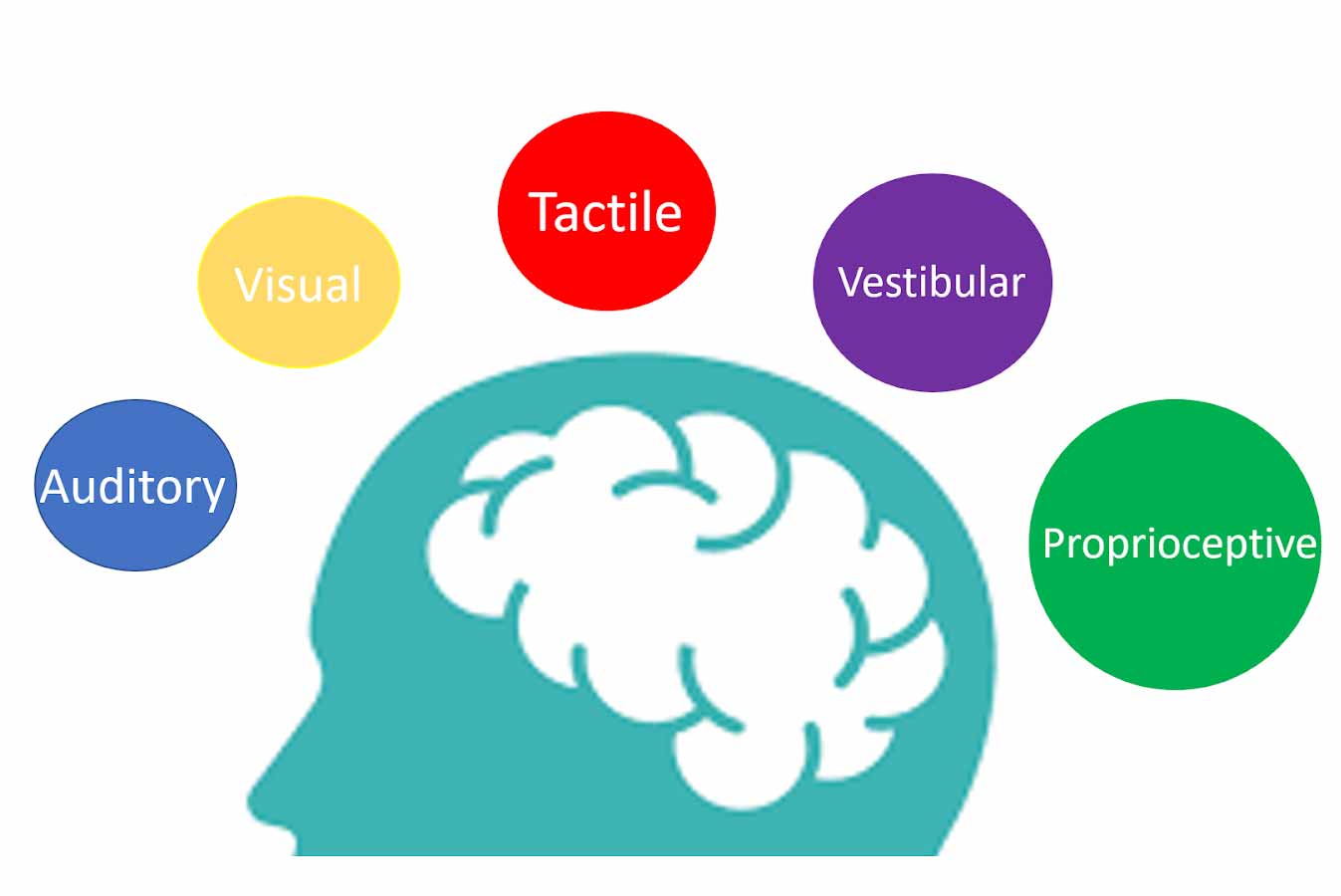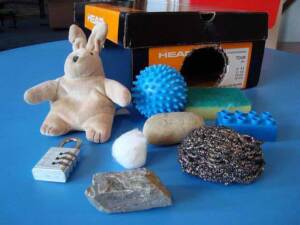
What Is Sensory Integration and Processing?
The concept of sensory integration and processing comes from a body of work developed by A. Jean Ayres, PhD, OTR. Dr. Ayres created a framework that focuses on understanding how sensory integration and processing develops through active participation in ordinary childhood activities. Sensory integration and processing applies to the way the nervous system receives information from the senses and turns them into appropriate motor and behavioral responses. These appropriate motor and behavioral responses are called adaptive responses, a term coined by Dr. Jean Ayres. Efficient sensory integration and processing allows individuals to appropriately register, interpret, and attend to sensory input from the environment and within the body to achieve higher level motor, cognitive, and social emotional skills. Along with appropriately registering, interpreting, and attending to sensory input, individuals must maintain an appropriate level of alertness. This ability to regulate and maintain an appropriate level of alertness is called sensory modulation.
Beginning from a young age, we are constantly provided with sensory information from the environment and our own bodies, which our brain must begin to organize. Depending on how these complex interactions are organized, our behaviors may be impacted. The slightest change in our brain processes can influence how we cope with everyday life. Some children may have difficulty processing information from the senses efficiently. Difficulties with sensory integration and processing can lead to poor sensory modulation. A child with poor sensory modulation may demonstrate over-responsivity or under-responsivity to sensations, maladaptive responses, or fear during everyday occupations, such as self-care, play, or school. Additionally, poor sensory modulation can affect a child’s motor skills, activity level, learning, emotional regulation, behavior, social skills, and overall participation and engagement in meaningful occupations. That is why it is important for a child with sensory processing difficulties to be evaluated to determine appropriate intervention which includes child-focused intervention, family-focused intervention, and environmental supports and modifications.
Skilled occupational therapists (OT) or certified occupational therapy assistants (COTA) have training in Dr. Ayres’ sensory integration and processing framework and how play influences child development. OTs and COTAs will help guide a child through sensory based activities that challenge their ability to respond appropriately to sensory input by making a successful, organized response. The exposure to specific sensory stimuli during skilled OT interventions will help improve sensory integration and processing in order to increase a child’s ability to feel comfortable in their skin and to successfully navigate sensory-filled world.
The Sensory Systems
According to Dr. Ayres’ research, somatosensory systems include the tactile, the proprioceptive, and the vestibular sense. These sensations help to organize the body’s posture, movement and body scheme. The sensory systems which provide information about the environment (outside the body) are the visual and auditory sense. Each of the sensory systems can have an alerting or a calming influence on the individual and the task at hand. These sensory systems can work individually or together to help us understand what is happening inside and outside our bodies and how we must respond.
Smell and taste are also sensory systems, but have not been addresses in this resource guide. A relatively newly identified sensation, interoception, often called the eighth sensory system, also has not been addresses in this guide. Interoception allows us to “feel” inside our body and give information about the internal state or condition. This could be recognizing and responding to the sensations of a full bladder, an empty stomach or being able to pair a body sensation such as a fluttery stomach or a racing heart to an emotion such as nervousness.
This guide will provide more information about the following sensory systems: tactile, proprioception, vestibular, visual, and auditory and also provide suggested activities. The activities can be used at home or in the community and are considered environmental supports that can assist a child to be successful throughout their day.
Tactile
Tactile or touch input provides us with important information about the world we interact in. Tactile receptors provide information about deep touch pressure, texture, temperature, light touch, vibration, and pain. Steady deep pressure (hugs) tends to be calming; light touch tends to be alerting (think a spider web on your arm or face). Children with sensory processing difficulties may be overly sensitive/over-responsive to touch or under-responsive to touch.
Children who are over-responsive to touch may have difficulty sitting beside others, avoid ‘messy’ play, have a fearful response to unexpected touch, avoid hair washing and tooth brushing, and dislike certain food textures. Children who are under-responsive may have difficulty noticing when someone touches them, may touch others and objects frequently, are messy eaters (not aware of food on their face), and have difficulty recognizing wet or twisted clothing.
Proprioception
Proprioceptive input from muscles and joints provides us with a sense of muscles and joint receptors working in our bodies to provide an understanding of the position of our body in relation to itself and the environment. Additionally, proprioceptive input helps us detect and control force, speed, and pressure. We use our proprioceptive input to know where our bodies are in space (body awareness) and to generate coordinated movements.
Children with sensory processing difficulties may be overly sensitive/over-responsive or under-responsive to proprioceptive input. Children who are over-responsive to proprioceptive input may be stiff, uncoordinated and clumsy, constantly scared of falling or may have difficulty ascending and descending stairs. Children who are under-responsive may lean, bump, or crash against objects and people, manipulate crayons and everyday objects with too much force often breaking things, and/or slap their feet, stomp around, or sit on their feet to get additional feedback from the receptors.
Vestibular
Vestibular sensory input provides us with information about balance, gravity, and where our body is in space (if we are still or moving, how fast we are moving, and in what direction). Additionally, the vestibular system, through its influence on muscle tone, provides information about moving and maintaining an upright posture. The vestibular system also influences ocular motor muscles and contributes to conjugate vision, as well as, coordinating movements of the head with the eyes to maintain visual fixation. Vestibular receptors (semicircular canals and otoliths) are located in the inner ear. Quick and fast movements tend to be alerting, while slow movements tend to be calming.
Some children may have difficulty processing vestibular input. These children may be over-responsive or under-responsive or have mixed sensitivities to vestibular sensory input. Over-responsiveness to vestibular input may cause children to be cautious, slow moving, and sedentary. They might avoid or have a fearful, emotional reaction with changes in the body’s position and its relationship to gravity. Examples of activities that cause fear and emotional reactions include moving the head backwards when washing hair, going down a slide, standing on a tall play structure, walking across a moving bridge. Under- responsiveness to vestibular input may cause children to crave intense, fast, and spinning movement, be a thrill seeker, need to move constantly, have poor balance, or bump into objects on purpose.
Visual
The visual sense provides us with information about color, size, brightness, shape, texture, depth, and space. Visual receptors are rods and cones located in the retina of the eye. Processing input from the visual system provides information about the color, size, brightness, shape, texture, depth, and surrounding space. This information is different from visual acuity or sharpness of vision. Children with difficulty processing visual input may have difficulty regulating visual input. Examples include being easily distracted by moving objects or being overly sensitive to light.
Children may be over-responsive or under-responsive to visual input. Children who are over-responsive to visual input may demonstrate discomfort with bright lights and/or fluorescent lighting, prefer spending time in dark environments, have difficulty making eye contact, or are easily distracted by visual stimuli in the room, such as movement or toys. Children who are under-responsive to visual input may have difficulties finding objects in a room or gravitate towards bright, shiny, spinning objects, and sometimes become fixated on these objects.
Auditory
The auditory sense allows us to identify loud, soft, high, low, near, and far noises in the environment. The qualities of the auditory input can be alerting and calming. For example, unexpected loud noises are alerting, while soothing, rhythmic music or sounds are calming. Some children may have difficulty with processing auditory input. These children may be over-responsive or under-responsive to auditory input.
Children who are over-responsive to auditory input may be easily distracted by background noise, dislike noisy settings, or respond negatively to unexpected noises or sounds. Children who are under-responsive to auditory input may not hear what you say or make noises to keep focused on a task.
References
- Ayres, A. J. (1979). Sensory integration and the child. Los Angeles, CA: Western Psychological Services.
- Kranowitz, Carol Stock. (2005). The out-of-sync child: Recognizing and coping with sensory processing disorder. New York, NY: Penguin Putman Inc.
- Miller, Lucy Jane. (2006) Sensational kids: Hope and help for children with sensory processing disorder (SPD). New York, NY: GP Putnam’s Sons.
- Reynolds, S. & Andelin, L. (2018). Family Engagement: Supporting Children with Sensory Processing Differences. OT Practice, July 9, 2018.
Compiled by Linda King-Thomas MHS, OTR/L, C/NDT and Kristina Nguyen MOT
March 2022

